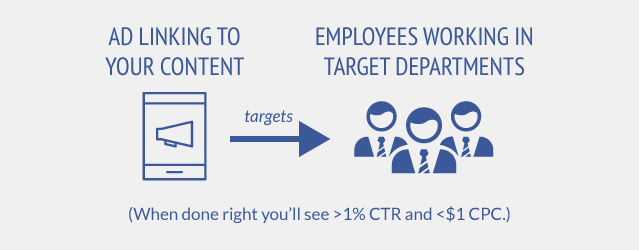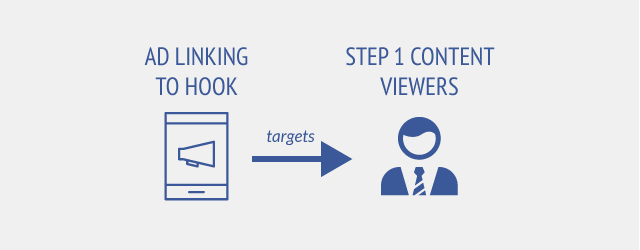Home > Ideas > How to Generate Scalable Leads with Facebook Ads (Feb '17)
How to Generate Scalable Leads with Facebook Ads
This is the text version of this infographic.
Ads work best when they conform to the media on which they appear. Since Facebook is mostly about sharing and discovering content, Facebook ads work best when they're content-driven and indirect.
The following infographic explains a Facebook advertising strategy you can use to generate leads and sales for a B2B company. It fits the Facebook medium perfectly, generates huge ROI and is great fun to implement.
Strategy summary:
- Promote content to target department
- Retarget viewers with hook
- Referral ask to get warm prospect
- Qualify & enter sales cycle
Step 1 Promote content to target department
In this first step you create a great piece of content and show it to people who could benefit from your product or service. There should be no calls to action at this stage; all you’re trying to do is filter your potential market into a subset that has engaged with your content.

You want to target anybody who works in a department that your product or service could benefit (e.g. a company selling sales software would target VPs of sales, sales associates and so on). Facebook lets you target by job title which makes this very easy to do.
Step 2 Retarget viewers with hook
The second ad you set up retargets people who viewed your content from step one. It should be linked to a page that offers some kind of asset or resource (a ‘hook’) in exchange for some basic user details (name, email and company name).

Ideally the hook will be related to both the content from step one and your company’s offering. The more engagement and value you create, the easier it will be to get the user’s details.
Step 3 Referral ask to get warm prospect
By this stage you’ll have the name and email of someone who works in a department that could benefit from your product or service. In this step you send them a short email asking who you should talk to at their company about your product or service.
![Diagram showing an example email to send asking for a referral. Email showing how to referral ask. E.g. for a company selling prospecting software: Hello [Name], I hope this email finds you well. I’m trying to find the person at [Company] who handles prospecting and I’m a bit stuck. Could you possibly tell me the name and email of the relevant person please? Would really appreciate any help you can give.](/assets/images/facebook-advertising-strategy-3.png)
The trust that you built in steps one and two kicks in here to create engagement (look for a 10%+ reply rate). A good proportion of replies will be CCs to the right person. This step works best when the email is signed by the author of the content and resource from steps one and two.
Step 4 Qualify & enter sales cycle
Your first email to the prospect should suggest a specific time to discuss whether there might be a good fit between your companies. In case you only receive a contact in step three you should make sure to mention that you were referred by the user from steps one to three.
![Diagram showing an example email to send asking for an initial discovery call once you've been referred to the right person. Email showing how to request a call in your first email once you've done the referral ask. E.g. for a company selling prospecting software: Hello [Prospect], I hope this email finds you well. My name is [My name] and I work at [My company]. I’m reaching out because [User] referred me to you as the best person to talk to about [Category] at [Company]. Are you free for a quick chat on Friday to see if [My company] might be a good fit for [Company]? Say at 11am EST?](/assets/images/facebook-advertising-strategy-4.png)
A large proportion of prospects will reply and a good proportion will accept your call requests. Once you’ve established that there might be a fit you’ll have a qualified lead that you can take through your sales process and hopefully sell to.
Final Remarks
This strategy is a great way to generate a constant flow of warm leads from scratch. It makes high value use of your content and can be scaled easily by increasing your ad budgets. In short, it’s extremely effective and resource efficient. Try it out and see for yourself!
by Aftab Singh, Founder of AdLove (@affalytics) | Ideas home
